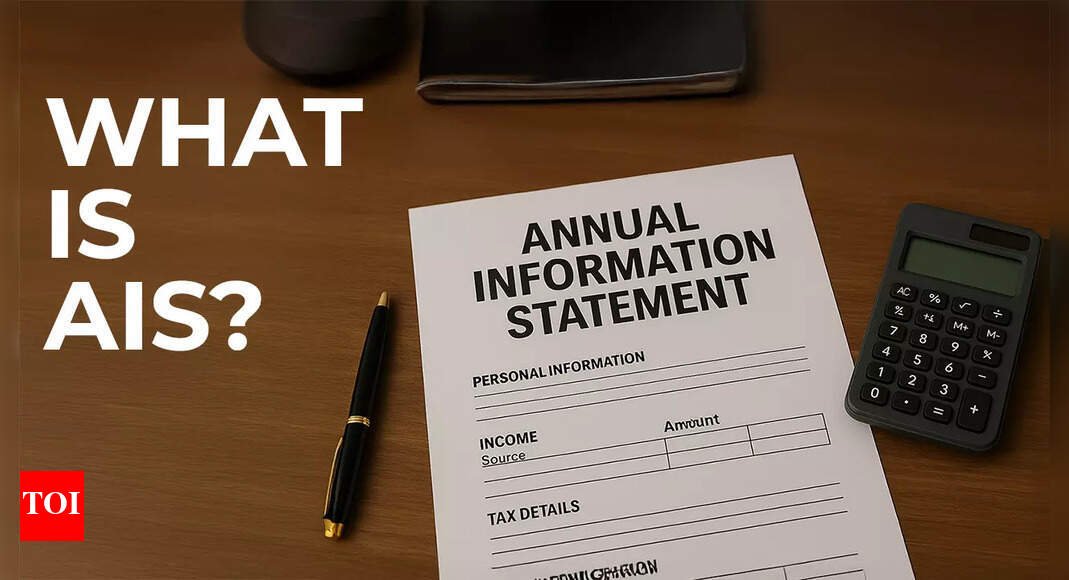ITR filing FY 2024-25: When filing your income tax return for FY 2024-25 (AY 2025-26), the Annual Information Statement is an important document that every taxpayer should be aware of. Introduced a few years ago, the Annual Information Statement is a helpful document for transparent and easy tax compliance.The Annual Information Statement serves as a crucial document that displays comprehensive details of a taxpayer’s financial transactions throughout the fiscal year. The Annual Information Statement (AIS) and Form 26AS are tools provided by the Income Tax Department to help taxpayers with accurate tax reporting.Individuals paying taxes have the ability to cross-check their income sources and ensure they align with their Form 16, Form 16A or personal financial records. The AIS system enables taxpayers to identify any inconsistencies in their declared income or tax remittances.Also Read | Income Tax Return e-filing: Can you keep switching between new and old tax regime every year? What taxpayers should knowAs AIS effectively records the majority of income sources, it aids in preventing omissions and understatements, thereby reducing the likelihood of tax avoidance penalties or evasion charges.To view their AIS, taxpayers need to visit the official e-filing website at https://www.incometax.gov.in and sign in with their account details. The statement is accessible under the ‘Services’ section, where users can select ‘Annual Information Statement’. Users have the option to obtain their yearly statement in either PDF or JSON formats for their preferred financial year.
What is the Annual Information Statement (AIS)?
- Sudhakar Sethuraman, Partner, Deloitte India explains that AIS is a comprehensive report capturing a taxpayer’s financial transactions during a financial year such as interest income, dividends, securities transactions, and foreign remittances, offering a broader view of income sources.
- These transactions are reported in AIS even if there is no associated tax deduction/ collection at source (TDS/TCS).
- AIS allows the taxpayer to provide feedback on the transactions reported therein. The tax office considers the feedback provided by the taxpayer and AIS is updated to show original and modified values based on this feedback.
- There is also a facility to view all feedback provided in the form of “AIS Consolidated Feedback” file which can be downloaded from the portal.
- As AIS provides securities-related transactions, it aids in comparison of the information reported in AIS with the information provided by the demat account. Securities transactions can be downloaded into excel and can be used for uploading into tax returns in the relevant sections (capital gains/business income).
How is AIS different from Form 26AS?
Sudhakar Sethuraman explains that unlike AIS, Form 26AS is more oriented towards TDS/TCS. It provides a list of incomes (such as salary, interest), TDS/TCS on these and types of tax payments such as advance tax. “Form 26AS helps taxpayers verify the taxes paid in various forms (such as TDS, TCS, advance tax, self-assessment tax) and the total tax credit available for the relevant financial year,” Sudhakar Sethuraman tells TOI.In short, AIS gives a detailed overview of income and transactions, while Form 26AS focuses on taxes.Also Read | ITR filing FY 2024-25: Do you need to file your income tax return if TDS has been deducted? Explained
var _mfq = window._mfq || [];
_mfq.push([“setVariable”, “toi_titan”, window.location.href]);
!(function(f, b, e, v, n, t, s) {
function loadFBEvents(isFBCampaignActive) {
if (!isFBCampaignActive) {
return;
}
(function(f, b, e, v, n, t, s) {
if (f.fbq) return;
n = f.fbq = function() {
n.callMethod ? n.callMethod(…arguments) : n.queue.push(arguments);
};
if (!f._fbq) f._fbq = n;
n.push = n;
n.loaded = !0;
n.version = ‘2.0’;
n.queue = [];
t = b.createElement(e);
t.async = !0;
t.defer = !0;
t.src = v;
s = b.getElementsByTagName(e)[0];
s.parentNode.insertBefore(t, s);
})(f, b, e, ‘https://connect.facebook.net/en_US/fbevents.js’, n, t, s);
fbq(‘init’, ‘593671331875494’);
fbq(‘track’, ‘PageView’);
};
function loadGtagEvents(isGoogleCampaignActive) {
if (!isGoogleCampaignActive) {
return;
}
var id = document.getElementById(‘toi-plus-google-campaign’);
if (id) {
return;
}
(function(f, b, e, v, n, t, s) {
t = b.createElement(e);
t.async = !0;
t.defer = !0;
t.src = v;
t.id = ‘toi-plus-google-campaign’;
s = b.getElementsByTagName(e)[0];
s.parentNode.insertBefore(t, s);
})(f, b, e, ‘https://www.googletagmanager.com/gtag/js?id=AW-877820074’, n, t, s);
};
function loadSurvicateJs(allowedSurvicateSections = []){
const section = window.location.pathname.split(‘/’)[1]
const isHomePageAllowed = window.location.pathname === ‘/’ && allowedSurvicateSections.includes(‘homepage’)
const ifAllowedOnAllPages = allowedSurvicateSections && allowedSurvicateSections.includes(‘all’);
if(allowedSurvicateSections.includes(section) || isHomePageAllowed || ifAllowedOnAllPages){
(function(w) {
function setAttributes() {
var prime_user_status = window.isPrime ? ‘paid’ : ‘free’ ;
var geoLocation = window?.geoinfo?.CountryCode ? window?.geoinfo?.CountryCode : ‘IN’ ;
w._sva.setVisitorTraits({
toi_user_subscription_status : prime_user_status,
toi_user_geolocation : geoLocation
});
}
if (w._sva && w._sva.setVisitorTraits) {
setAttributes();
} else {
w.addEventListener(“SurvicateReady”, setAttributes);
}
var s = document.createElement(‘script’);
s.src=”https://survey.survicate.com/workspaces/0be6ae9845d14a7c8ff08a7a00bd9b21/web_surveys.js”;
s.async = true;
var e = document.getElementsByTagName(‘script’)[0];
e.parentNode.insertBefore(s, e);
})(window);
}
}
window.TimesApps = window.TimesApps || {};
var TimesApps = window.TimesApps;
TimesApps.toiPlusEvents = function(config) {
var isConfigAvailable = “toiplus_site_settings” in f && “isFBCampaignActive” in f.toiplus_site_settings && “isGoogleCampaignActive” in f.toiplus_site_settings;
var isPrimeUser = window.isPrime;
var isPrimeUserLayout = window.isPrimeUserLayout;
if (isConfigAvailable && !isPrimeUser) {
loadGtagEvents(f.toiplus_site_settings.isGoogleCampaignActive);
loadFBEvents(f.toiplus_site_settings.isFBCampaignActive);
loadSurvicateJs(f.toiplus_site_settings.allowedSurvicateSections);
} else {
var JarvisUrl=”https://jarvis.indiatimes.com/v1/feeds/toi_plus/site_settings/643526e21443833f0c454615?db_env=published”;
window.getFromClient(JarvisUrl, function(config){
if (config) {
const allowedSectionSuricate = (isPrimeUserLayout) ? config?.allowedSurvicatePrimeSections : config?.allowedSurvicateSections
loadGtagEvents(config?.isGoogleCampaignActive);
loadFBEvents(config?.isFBCampaignActive);
loadSurvicateJs(allowedSectionSuricate);
}
})
}
};
})(
window,
document,
‘script’,
);
#ITR #efiling #Annual #Information #Statement #AIS #Form #26AS #Top #points #taxpayers



